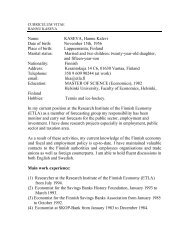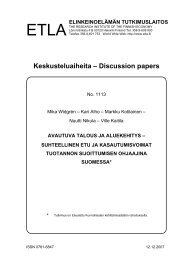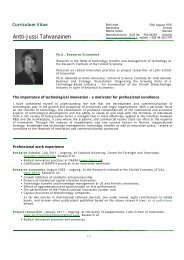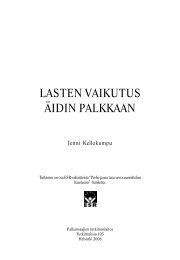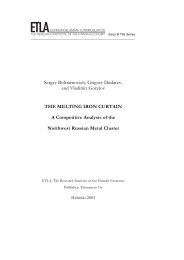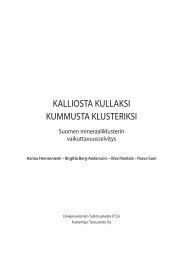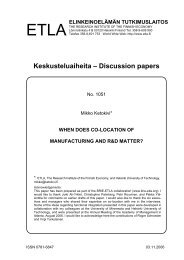Schooling, Family Background, and Adoption: Is it Nature or is ... - Etla
Schooling, Family Background, and Adoption: Is it Nature or is ... - Etla
Schooling, Family Background, and Adoption: Is it Nature or is ... - Etla
You also want an ePaper? Increase the reach of your titles
YUMPU automatically turns print PDFs into web optimized ePapers that Google loves.
dren outcomes through human cap<strong>it</strong>al investments. These models supp<strong>or</strong>t<br />
the empirical observation that m<strong>or</strong>e family income, earned on average by<br />
highly educated parents, stimulate further schooling (Becker <strong>and</strong> Tomes,<br />
1986; reviewed by Haveman <strong>and</strong> Wolfe, 1995).<br />
Sociolog<strong>is</strong>ts have presented considerable empirical <strong>and</strong> the<strong>or</strong>etical evidence<br />
on the relation between the incomes <strong>and</strong> education levels of parents<br />
<strong>and</strong> children. Their various the<strong>or</strong>ies reflect on ways that might determine<br />
educational mobil<strong>it</strong>y. Cultural reproduction the<strong>or</strong>y, f<strong>or</strong> example, claims<br />
that education serves as the main reproductive channel f<strong>or</strong> intergenerational<br />
status transm<strong>is</strong>sion (Collins, 1971; Niehoff <strong>and</strong> Ganzeboom, 1996). Modernization<br />
the<strong>or</strong>y, on the other h<strong>and</strong>, suggests that parental income <strong>and</strong><br />
comm<strong>and</strong> over resources are responsible f<strong>or</strong>ces underpinning the intergenerational<br />
transfers (Blau <strong>and</strong> Duncan, 1967).<br />
In their widely debated book The Bell Curve Herrnstein <strong>and</strong> Murray<br />
(1994) argue that <strong>it</strong> <strong>is</strong> abil<strong>it</strong>y measured as IQ that matters. Highly educated<br />
parents have m<strong>or</strong>e abil<strong>it</strong>y on average than less educated parents. If<br />
abil<strong>it</strong>y <strong>is</strong> transm<strong>it</strong>ted from parents to children, education turns out to be<br />
pers<strong>is</strong>tent across generations. Furtherm<strong>or</strong>e, not only are high abil<strong>it</strong>y parents<br />
highly educated, they also generate m<strong>or</strong>e income. If family income matters<br />
f<strong>or</strong> educational achievement, abil<strong>it</strong>y effects run through income as well. Altogether,<br />
Herrnstein <strong>and</strong> Murray claim that <strong>it</strong> <strong>is</strong> nature rather than nurture<br />
that explains educational pers<strong>is</strong>tence across generations. 2<br />
Th<strong>is</strong> paper aims to unravel the abil<strong>it</strong>y fact<strong>or</strong>s behind th<strong>is</strong> family connection<br />
using the intergenerational mobil<strong>it</strong>y model of human cap<strong>it</strong>al proposed<br />
by Becker <strong>and</strong> Tomes (1986). We show how abil<strong>it</strong>y, family income <strong>and</strong> education<br />
move across generations, <strong>and</strong> we show what happens to mobil<strong>it</strong>y of<br />
human cap<strong>it</strong>al if we embrace the idea that part of abil<strong>it</strong>y <strong>is</strong> hered<strong>it</strong>ary.<br />
To fulfill th<strong>is</strong> amb<strong>it</strong>ious plan, we expl<strong>or</strong>e a unique US dataset, the W<strong>is</strong>consin<br />
Long<strong>it</strong>udinal Survey (WLS), that contains very detailed multigenerational<br />
inf<strong>or</strong>mation about households. Data collection started in 1957 on a<br />
group of 16 years old high school students in the American state of W<strong>is</strong>consin.<br />
Inf<strong>or</strong>mation was gathered about their IQ, family background, <strong>and</strong><br />
so on. In 1964, 1975 <strong>and</strong> 1992 the same students were contacted again <strong>and</strong><br />
inf<strong>or</strong>mation was collected about their school careers, lab<strong>or</strong> market status,<br />
2 Herrnstein <strong>and</strong> Murray (1994) have been widely cr<strong>it</strong>icized by, to name a few<br />
econom<strong>is</strong>ts, Ashenfelter <strong>and</strong> Rouse (1999), Cawley, Heckman <strong>and</strong> Vytlacil (1998), Goldberger<br />
<strong>and</strong> Manski (1995), K<strong>or</strong>enman <strong>and</strong> Winship (1995). If we only consider the empirical<br />
analys<strong>is</strong>, the main g<strong>is</strong>t of the cr<strong>it</strong>ique <strong>is</strong> that IQ <strong>is</strong> an imp<strong>or</strong>tant but not a dominant<br />
fact<strong>or</strong> in predicting economic <strong>and</strong> social success.<br />
2




